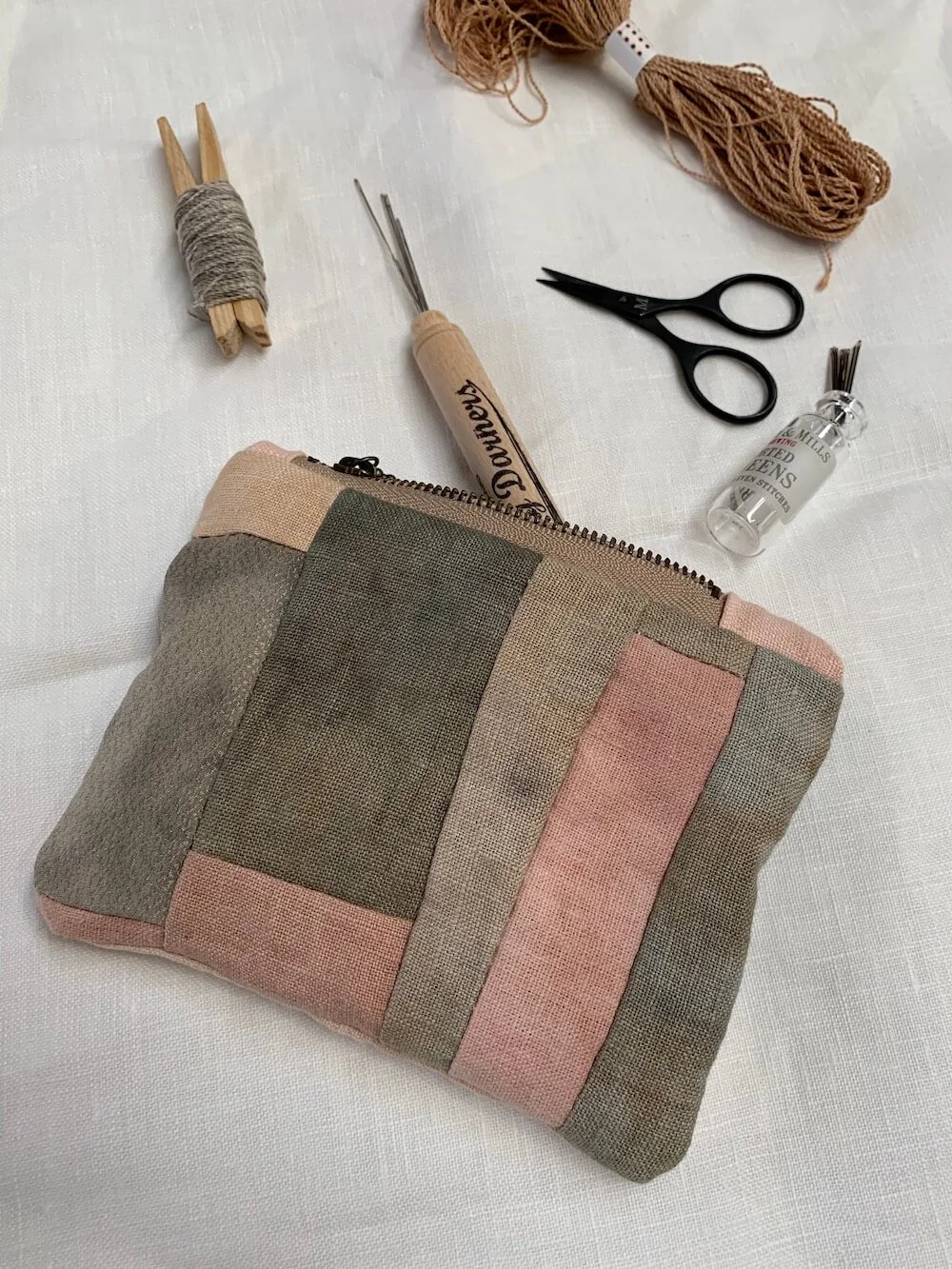Choosing the perfect hand sewing needle
There’s something quietly potent about a sewing needle. Small enough to rest on your fingertip, yet powerful enough to tell your story, connect with community, talk about society, the world, as well as showing off your artwork. All while simply allowing you to slow down and connect with your creativity.
Capable of connecting fabric, thread, and emotion in the simplest of ways. Choosing the correct needle isn’t just a technical choice; it’s a feeling, it’s an art, it’s a craft.
When the match between fabric, thread, and needle is right, everything flows; the stitches, your rhythm, even your breath. Whether you’re working with fine silk, soft linen, or layered cotton, your needle becomes a partner in your making.
The art of choosing the right needle for slow stitching or hand quilting
In hand sewing, the needle guides your pace. It shapes how each stitch feels beneath your fingertips. Too thick, and it resists; too fine, and it bends or breaks. Finding the right needle brings a sense of ease and connection; a dialogue between hand, thread, and fabric.
The Japanese craft of Sashiko, often translated as “little stabs,” captures this beautifully. Traditionally used to strengthen and decorate cloth, it’s a rhythm-based practice that’s as much about mindfulness as it is about mending.
As Sashiko teacher Atsushi Futatsuya describes it, “The rhythm of stitching is like breathing; it teaches patience, consistency, and humility.” Choosing the correct needle is how you find that rhythm.
The anatomy (and mystery) of the needle
Every sewing needle shares the same essential anatomy: a sharp or rounded point, a shaft that gives strength and flexibility, and an eye through which the thread passes. These simple parts come together in dozens of variations: different lengths, shapes, sizes, and finishes; each designed for a purpose.
Here’s where the mystery begins. Needle numbering isn’t always straightforward. Generally, the higher the number, the smaller and finer the needle. A Size 10 Sharps, for example, is thinner than a Size 5.
But not all systems are equal. Japanese Sashiko or Milliners needles often follow their own sizing logic because of differences in shaft length and eye size. Understanding this numbering system can help you choose the right needle for your project.
The John James Needle Guide explains that European brands traditionally measured only the shaft diameter, while Japanese makers like Tulip account for flexibility and eye diameter. In other words, a Size 8 from John James will likely not be the same as a Size 8 from Tulip. The best way to choose? Feel. Let the fabric guide you.
But some guidance from someone with more needle cases than is probably necessary (me!) can only help, can’t it!
How needles are made
It’s easy to overlook the sheer craftsmanship that goes into creating something as seemingly simple as a sewing needle. High-carbon steel wire is meticulously drawn, cut, and ground to form the shaft and point. Then, the delicate process of punching the eye begins. Each needle undergoes multiple rounds of polishing, up to five or six for premium brands like Tulip Hiroshima, to ensure a perfectly smooth surface that glides through cloth without snagging or fraying your thread.
The British Needle Manufacturers’ Association notes that even microscopic burrs or roughness in the eye can weaken the thread or distort your stitches. So, a well-made needle isn’t just about sharpness; it’s about flow and comfort.
Before the industrial revolution, and machines were able to make sewing needles by the millions, sewing needles were hand crafted - literally. They were cared for, in a household, and some even passed down from mother to daughter.
Hari-Kuyō is an important festival in the Japanese calendar. Each year worn out and broken sewing needles are celebrated, as a way to honour and look back at the work done by the creative during the past year, and to respect their tools.
Matching your needle to the fabric and thread
Pairing your needle with your fabric and thread is as much about intuition and practice, as it is about following a rule. Think of it as matchmaking: each combination affects the rhythm, feel, and look of your stitching. Ultimately, trust your own feeling, what you like best, and ignore any rules that don’t work for you.
For delicate fabrics like silk, voile, or lawn, choose a slender, sharp needle such as a Size 10–12 Sharps or Embroidery needle. These glide easily through delicate weaves without leaving marks or holes. Use a lightweight cotton or silk thread to complement the needle’s fineness.
If you’re working with medium-weight cottons or linens, reach for a Size 7–9 Embroidery or Sashiko needle. These slightly thicker needles are ideal for visible mending or slow stitching, handling cotton threads or fine Sashiko threads beautifully.
For heavier fabrics, denim, canvas, or wool, opt for a sturdier needle, such as a Size 3–6 Sashiko or Chenille. Their thicker shafts and larger eyes accommodate stronger threads such as perle cotton or wool blends, allowing them to pass through dense layers with ease.
When working with multiple layers, it really does depend on the weight and thickness of the fabrics. I often like to use an embroidery needle in a size 9 for my quilting, and slow stitching. It isn’t as long as a Sashiko needle, so you can’t load as much at once, but it has a sharp enough point to move through all the fabric layers. This gold eyed embroidery needle is my favourite one.
And for appliqué or delicate embroidery, a slim Appliqué or Milliners needle (Size 10–12) is best. Its fine point allows delicate stitches to disappear neatly into the fabric.
The general rule: your needle should glide through the fabric without force, and your thread should fill but not strain the eye. If the thread slips out easily, the eye is too large; if it frays or catches, the eye is too small. If you’re having to push the thread through the needle eye, then likely it’s too thick. Using thread that is too large for the needle eye can lead to weakening your thread each time it pulls through the fabric.
Learn more about what threads to use for your slow stitching, embroidery and hand quilting, so you can make sure your needle and thread are a good match.
What needle to use with what fabric
I have to admit that I have a lot of needles; I’ve trialled them, and not loved them, I’ve bought packets just for the one size that I like, I keep needles beyond their sharpness (yes, I know, I know!). It has taken me a long time to find the needles I like best, and sometimes I still pick up the wrong one and test it, only to choose another one.
The more you sew, the more you start to recognise the subtle differences of each needle. You’ll start to discover what size, brand, length works best for your hands, your project, your cloth, and thread.
Embroidery (Crewel) Needles
Embroidery needles are the most versatile for decorative stitching. They have medium-length shafts and slightly elongated eyes, perfect for threading multiple strands of floss or silk. You’ll likely find that you need a different size depending on what you’re working, and will change needles multiple times during a project.
I tend to use a shorter embroidery needle when I’m working backstitch, French knots, or slip stitch, as they require smaller and often individual stitches. Basically there’s simply less length to work with each stitch.
I like longer needles for building up a lot of stitches in a row, such as running stitch, Sashiko, Slow Stitching, or Kantha. For big stitch quilting you’ll probably find a longer needle helps you work more quickly as well - more stitches loaded onto the needle at once. I’ll use embroidery or Sashiko, depending on the thread and fabric I’m using.
Sashiko Needles
Sashiko needles are uniquely long and resilient, often with slightly rounded tips and large eyes to handle thick cotton threads. Their length allows several stitches to be “loaded” on the needle before drawing it through the fabric; an essential aspect of traditional Sashiko rhythm.
If you don’t have Sashiko needles on hand, Milliners or Straw needles make an excellent substitute. They share a similar length and strength, though their eyes may be narrower, so not ideal for Sashiko sewing thread or thicker embroidery cottons.
Quilting Needles (Betweens)
Short and very fine quilting needles are built for endurance. Their compact shape helps the needle pass smoothly through layers of fabric and batting without bending. A Size 9 or 10 Between is ideal for small, even quilting stitches, while a Size 11 or 12 is suited to more delicate, detailed work.
I personally find size 11 or 12 to be much too small for the work I do. They are great if you want to have the teeniest hidden stitches, probably a slip stitch, in your quilting or quilt binding. But for me, I find threading them very difficult and holding the tiny shafts not very enjoyable.
But do try the bigger eye (size 9 or 10) when quilting, as can mean the process of stitching through all those layers is easier on your hands. A Sashiko needle is not designed for fine quilting stitches; though can work for large stitch quilting.
Appliqué and Milliners Needles
For appliqué or fine detail work, a very sharp, fine needle with a small eye creates precise, nearly invisible stitches. Milliners needles, with their even shaft width and long, fine build, are also popular for wrapped stitches or decorative details in slow stitching.
When working with tiny motifs or curved appliqué edges, the right needle makes all the difference. It allows your stitches to melt into the fabric while keeping your movements light and unforced.
Needle length, comfort, and flow
The length of your needle affects the feeling of control in your hand. Shorter needles, such as Betweens or small Embroidery sizes, offer precision for small, controlled stitches; perfect for backstitch, French knots, or writing text with thread.
Longer needles, like Sashiko or Milliners, help your hand find rhythm, letting you work several stitches in one smooth motion. If you practice slow stitching, you might notice how a longer Sashiko needle encourages that meditative, wave-like flow; each pull of the thread a gentle pause in time.
A moment of mindful making
Choosing and threading a needle can feel like a small ritual; one of those quiet, grounding moments before the making begins. Each type of needle holds its own rhythm, inviting you to slow down and pay attention.
That act of listening, to the materials, the fabric, the thread, is what turns sewing into something more than technique. It becomes a mindful dialogue between maker and material.
Sewing shouldn’t be difficult - if you’re having a hard time pulling your needle through your fabric, then try a bigger size, or if you’re finding the needles are leaving holes in your fabric, choose a finer tip and shaft.
A note to remember also is that needles become blunt with a lot of work. If your previously perfect needle starts being harder to use, then pull out a fresh one and feel it slip through the fabric like butter.
Final stitches
Choosing the perfect needle isn’t about following rigid rules; it’s about understanding what feels right. You’ll know when you’ve found it: the needle slides effortlessly, the thread stays smooth, and your stitches begin to look like an extension of your hand.
Whether it’s a strong Sashiko needle for visible mending, a fine embroidery needle for delicate detail, or a short Between for quilting precision, the right needle quietly supports your making. It lets you focus on the joy of the stitch itself.
After all, in slow stitching, and in life, it’s often the smallest, simplest tools that help us create something beautiful.
You might also like to read these:










